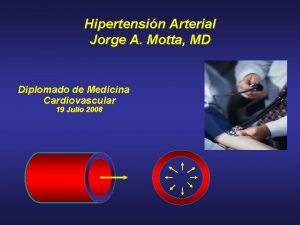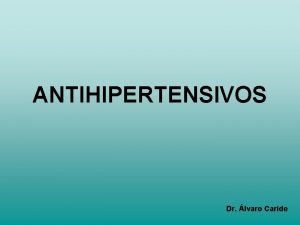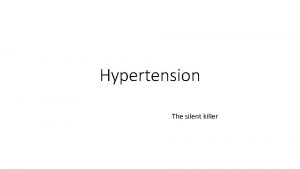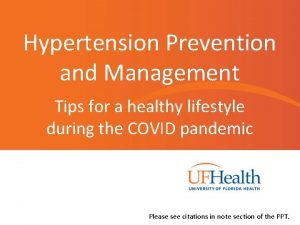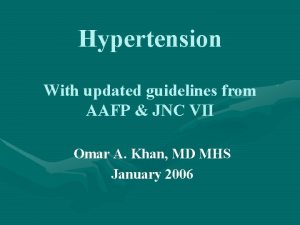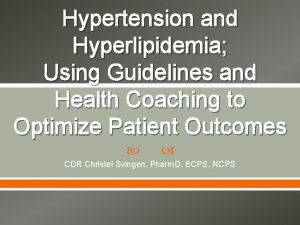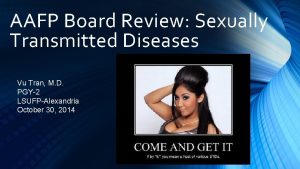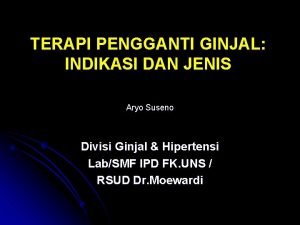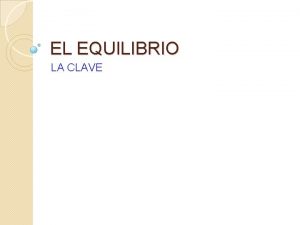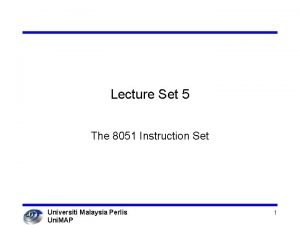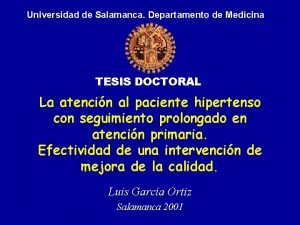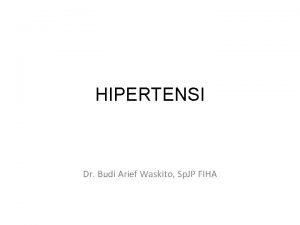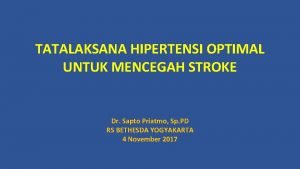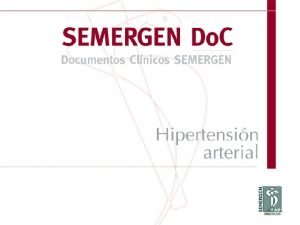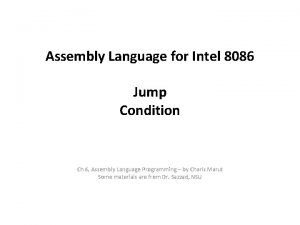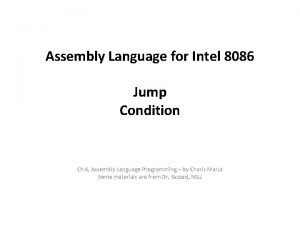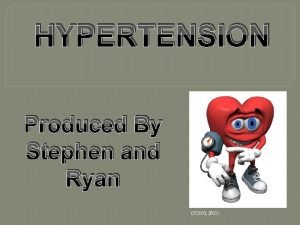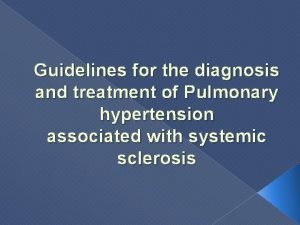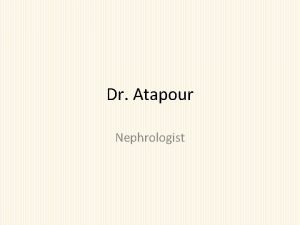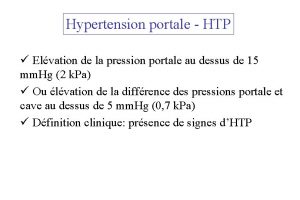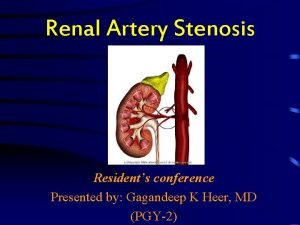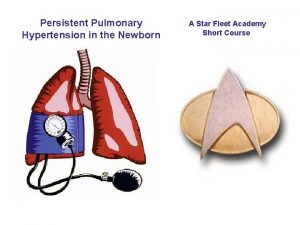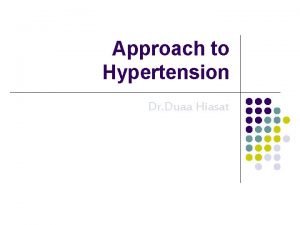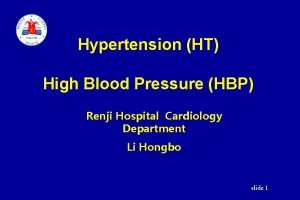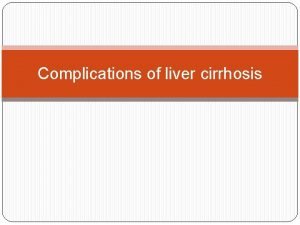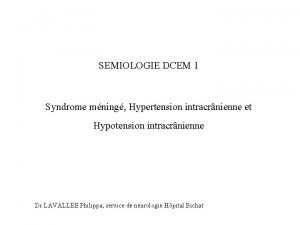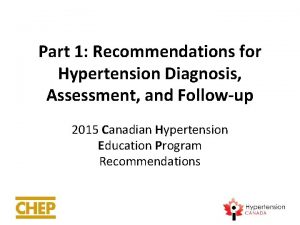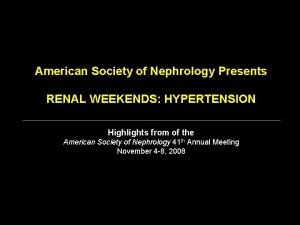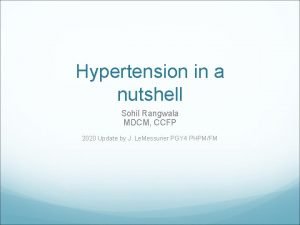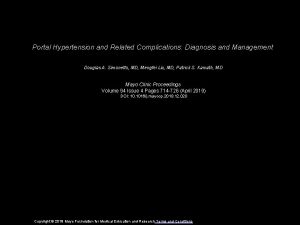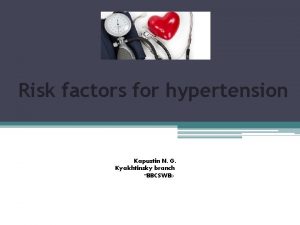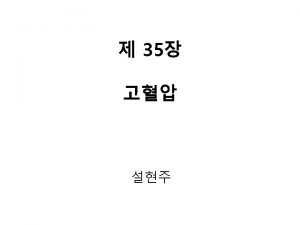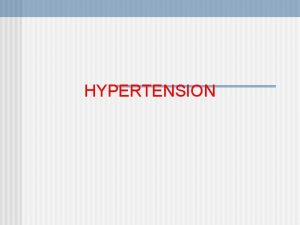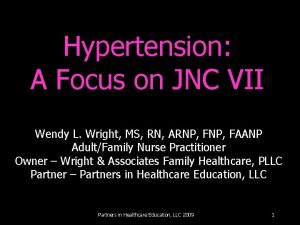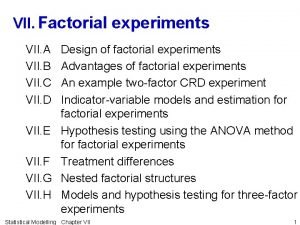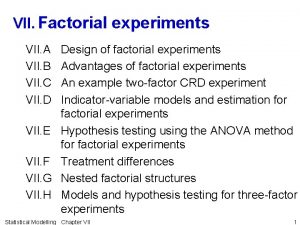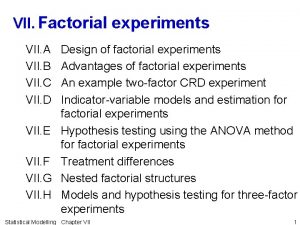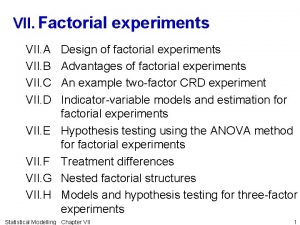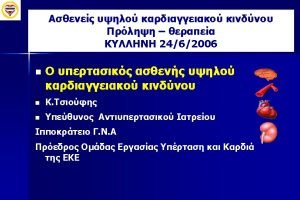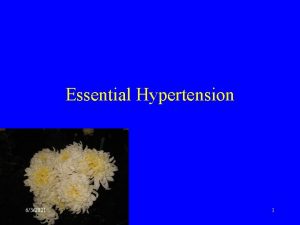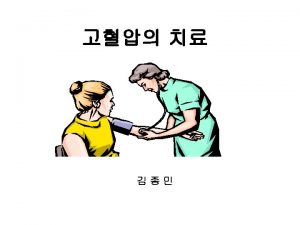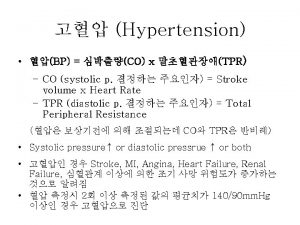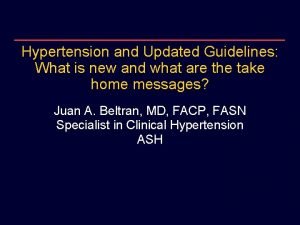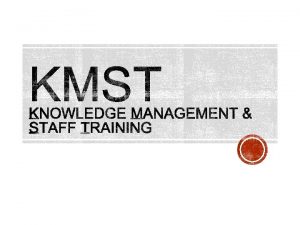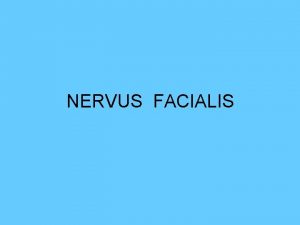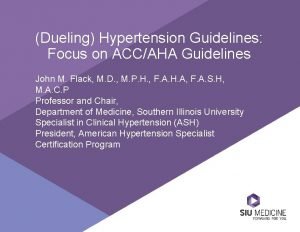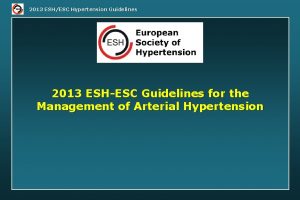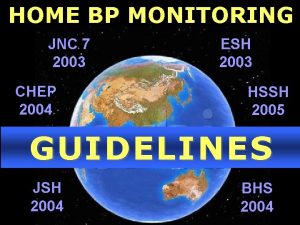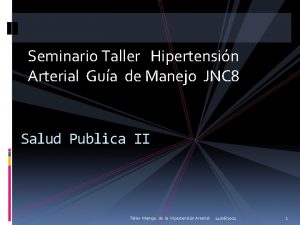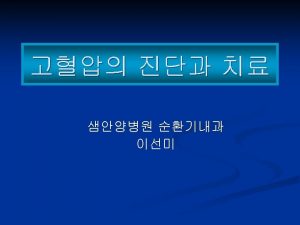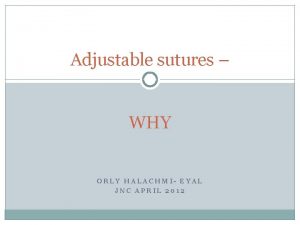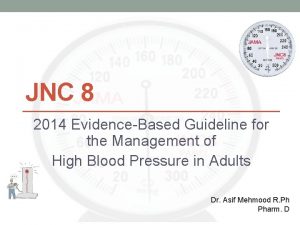Hypertension With updated guidelines from AAFP JNC VII
















































- Slides: 48

Hypertension With updated guidelines from AAFP & JNC VII Omar A. Khan, MD MHS January 2006

Objectives • Review the AAFP/JNC VII diagnostic criteria for hypertension • Review various treatment options, indications and side effects

Fast Facts about Hypertension in the US: • • • Hypertensive population: Controlled hypertensives: Those unaware of Dx: Aware but untreated: Of those treated: uncontrolled 42, 000 27% 13, 000 7, 000 58%

JNC VII

JNC VII

JNC 7: Classification and Management of Blood Pressure for Adults Initial Drug Therapy BP Classification SBP* (mm Hg) DBP* (mm Hg) Lifestyle Modification Normal <120 and <80 Encourage 120– 139 or 80– 89 Yes No antihypertensive drug indicated. Yes Thiazide-type diuretic Drug(s) for most. May consider compelling ACEI, ARB, BB, indications. CCB, or combination. Yes Two-drug combination for most (usually thiazide-type diuretic and ACEI or ARB or BB or CCB). Prehypertension Stage 1 hypertension Stage 2 hypertension 140– 159 ³ 160 or 90– 99 or ³ 100 JNC 7. May 2003. NIH publication 03 -5233. Without Compelling Indications With Compelling Indications Drug(s) for compelling indications. Other antihypertensive drugs (diuretic, ACEI, ARB, BB, CCB) as needed.

Diagnostic Workup

CVD Risk Factors • • • HTN • Inactivity Obesity • Age: >55 in men Hyperlipidemia >65 in women Diabetes • Fam history of Cigarette Smoking premature CVD



JNC 7: Treatment Algorithm for Hypertension Lifestyle modifications Not at goal blood pressure (<140/90 mm Hg) (<130/80 mm Hg for those with diabetes or chronic kidney disease) Initial drug choices Without compelling indications Stage 1 hypertension (SBP 140– 159 or DBP 90– 99 mm Hg) Thiazide-type diuretic for most. May consider ACEI, ARB, BB, CCB, or combination. Stage 2 hypertension (SBP ³ 160 or DBP ³ 100 mm Hg) Two-drug combination for most (usually thiazide-type diuretic and ACEI or ARB or BB or CCB). With compelling indications Drugs for compelling indications Other antihypertensive drugs (diuretic, ACEI, ARB, BB, CCB) as needed. Not at goal blood pressure Optimize dosages or additional drugs until goal blood pressure is achieved. Consider consultation with hypertension specialist. SBP=systolic blood pressure; DBP=diastolic blood pressure; ACEI=angiotensinconverting enzyme inhibitor; ARB=angiotensin receptor blocker; BB=b-blocker; CCB=calcium channel blocker JNC 7. May 2003. NIH publication 03 -5233.

Compelling Indications • Heart Failure: • • • Post- MI: High CVD risk: DM: Ø Thiazide/loop, BB, ACEi, ARB, Aldosterone antagonist Ø BB, ACE, Aldosterone antagonist Ø Thiazide, BB, ACE, Ca channel blocker Ø Thiazide, BB, ACE, ARB, CCB • CRF – Cr > 1. 5 in men Ø ACE, ARB. For creatinine 2 -3 try – Cr > 1. 3 in women loop diuretic • S/P CVA Ø Thiazide, ACE inhibitor

Lifestyle Modifications to Manage HTN Modification Recommendations Approximate Systolic Blood Pressure Reduction Weight Reduction Maintain normal body weight (BMI 18. 5 -24. 9) 5 -20 mm Hg for each 10 kg weight loss Adapt DASH eating plan Consume diets rich in fruits, vegetables, low fat dairy and low saturated fat 8 -14 mm Hg Dietary sodium reduction Reduce sodium to no more than 2. 4 g/day sodium or 6 g/day Na. Cl 2 -8 mm Hg Increase physical activity Engage in regular aerobic activity such as walking (30 min/day on most days) 4 -9 mm Hg Moderate alcohol consumption Limit alcohol to no more than 2 drinks/d for men and 1 drinks/day for women. 2 -4 mm Hg Source: The Seventh Report of the Joint National Committee on Prevention, Detection, Evaluation, and Treatment of High Blood Pressure JNCVII. JAMA. 2003; 289: 2560 -2572.

Failures of Patient Education • 50% of patients discontinue their antihypertensive within 1 year of initiating treatment. • DASH diet for hypertension: – limit sodium – Increase fruits and vegetables (8 -10/d) – Increase low fat dairy (3 -4/d) • Focus on diet history for hypertensive patients

Key Diet History Questions for Patients with HTN • Do you use a salt shaker? • Do you taste your food before you add salt? • How often do you eat salty foods, such as chips, pretzels, salted nuts, canned and smoked foods? • Do you read labels for sodium content? • How many servings of fruits and vegetables do you eat everyday? • How often do you eat or drink dairy products? What kind? • How often do you eat out? What kinds of restaurants? • Do you like to drink alcohol? How much? • How often do you exercise, including walking?

TIPS on drugs for HT • CCB OK for isolated systolic hypertension (ISH) • For DM: ACEi or ARB with or without diuretic, then add BB or CCB • When ACEi causes cough, substitute ARB • Don’t use short acting CCB (increases deaths due to arrhythmias). • Alpha blockers (e. g. clonidine) only as second line (more side effects).

• Most patients should start with a diuretic as they enhance the effectiveness of other agents. • Most patients will require more than one agent. • Add a baby aspirin to improve cardiovascular outcomes.

Special Populations • Minorities: • Blacks have greater prevalence, severity, and impact and poorer response to monotherapy. ACE induced angioedema is more common • Women: • Estrogen containing oral contraceptives elevate BP. Aldomet, BB, and vasodilators OK in pregnancy • Aged: • Higher prevalence, ISH more common, more frequent complications from ACE, CCB

Thiazides • • • Chlorothiazide (Diuril) Chlorthalidone Hydrochlorthiazide(Microzide, Hydrodiuril) Polythiazide (Renese) Indapamide (Lozol) Metolazone (Mykrox, Zaroxolyn) *All trade / brand / generic names are specific to the USA

Benefits of Thiazide Diuretics • Evidence-based support for end points that matter (prevention of CV and all-cause mortality). • Reduced calcium excretion is a potential benefit for osteoporosis prevention.

Loop Diuretics • Bumetanide • Furosemide • Torsemide (Bumex) (Lasix) (Demadex) Potassium-sparing Diuretics • Amiloride • Triamterene (Midamor) (Dyrenium) *All trade / brand / generic names are specific to the USA

Aldosterone Receptor Blockers • Eplerone (Inspra) • Spironolactone (Aldactone) Combined alpha- and beta- blockers • Carvedilol (Coreg) • Labetalol (Normodyne, Trandate) *All trade / brand / generic names are specific to the USA

Beta-blockers • • Atenolol Betaxolol Bisoprolol Metoprolol • • • Nadolol Propranolol Timolol (Tenormin) (Kerlone) (Zebeta) (Lopressor, Toprol XL) (Corgard) (Inderal/XL) (Blocadren) *All trade / brand / generic names are specific to the USA

ACE inhibitors • • • Benzapril Captopril Enalpril Fosinopril Lisinopril Moexipril Perindopril Quinapril Ramipril Trandolapril (Lotensin) (Capoten) (Vasotec) (Monopril) (Prinivil, Zestril) (Univasc) (Aceon) (Accupril) (Altace) (Mavik) *All trade / brand / generic names are specific to the USA

Angiotensin II Receptor Blockers • • Candesartan Eprosartan Irbesartan Losartan Olmesartan Telmisartan Valsartan (Atacand) (Tevetan) (Avapro) (Cozaar) (Benicar) (Micardis) (Diovan) *All trade / brand / generic names are specific to the USA

Calcium channel blockers • Dihydropyridines – Amlodipine (Norvasc) – Felodipine (Plendil) – Isradipine (Dynacirc CR) – Nicardipine (Cardene SR) – Nifedipine (Adalat CC, Procardia XL) – Nisoldipine (Sular) • DHPs can have negative inotropic effects, unlike non-DHPs, so use with caution in pts with impaired cardiac function

Calcium channel blockers • non-Dihydropyridines: – Diltiazem (Cardizem CD, Dilacor XR, Tiazac, Cardizem LA) – Verapamil (Calan SR, Isoptin SR) *All trade / brand / generic names are specific to the USA • DHPs can have negative inotropic effects, unlike non-DHPs, so use with caution in pts with impaired cardiac function

Alpha 1 blockers • Doxazosin • Prazosin • Terazosin (Cardura) (Minipress) (Hytrin) *All trade / brand / generic names are specific to the USA

Direct Vasodilators • Hydralazine (Apresoline) • Minoxidil (Loniten) *All trade / brand / generic names are specific to the USA

Centrally acting drugs • • Clonidine Methyldopa Reserpine Guanfacine (Catapres) (Aldomet) (generic) *All trade / brand / generic names are specific to the USA

Again: Treatment Algorithm Lifestyle Modification Not at goal BP Initial Drug Choices W/O Compelling Indications Stage 1 With Compelling Indications Stage 2 Thiaz, ACE, ARB, BB, CCB Drug for Indication 2 Drug Combo Not at Goal BP Adjust Dose or additional agents

References • JNC 7 report: available via NIH (Publication ( 03 -5233) • JAMA 289 (19), May 21 2003 (online) • AAFP monograph: #305

HTN True or False • ACE Inhibitors should be initial drug therapy for most, either alone or combined with other drug classes.

False • ACE Inhibitors Thiazides should be initial drug therapy for most, either alone or combined with other drug classes.

True or False • For persons over age 50, DBP is more important than SBP as CVD risk factor.

False • For persons over age 50, SBP is a more important than DBP as CVD risk factor.

True or False • Normal blood pressure is defined as SBP < 135 and DBP < 90.

False • Normal blood pressure is defined as SBP < 120 and DBP < 80. People with SBP 120 – 139 OR DBP 80 – 89 should be considered prehypertensive.

True or False • Those people whose BP is classified as prehypertensive should be initially treated with lifestyle modification from the time they are identified.

True • Those people whose BP is classified as prehypertensive should be initially treated with lifestyle modification from the time they are identified.

• Key lifestyle modification measures that, if initiated in all prehypertensive and hypertensive individuals, are likely to lower BP, include all except…. . • • • a) Weight reduction b) DASH Eating Plan c) Smoking cessation d) Dietary sodium reduction e) Physical activity f) Moderation of alcohol intake

• Key lifestyle modification measures that should be initiated in all prehypertensive and hypertensive individuals in order to lower BP include all except…. . • • • a) Weight reduction b) DASH Eating Plan c) Smoking cessation d) Dietary sodium reduction e) Physical activity f) Moderation of alcohol intake

True or False • If BP is >20/10 mm. Hg above goal, initiate therapy with a single agent and lifestyle modification.

False • False. If BP is >20/10 mm. Hg above goal, initiate therapy with two agents, one usually should be a thiazide-type diuretic.

True or False • Self measurement can help assess “whitecoat” HTN.

True • Self measurement can help improve adherence with therapy, provide helpful information on response to therapy and assist in assessing “white-coat” HTN.

True or False • Most patients will only require one antihypertensive drug to achieve goal BP.

False • Most patients will require 2 or more antihypertensive drugs to achieve goal BP
 Betabloqueadores
Betabloqueadores Diuréticos ahorradores de potasio
Diuréticos ahorradores de potasio Classification of hypertension
Classification of hypertension American heart association 2020
American heart association 2020 Disease state awareness
Disease state awareness Demadex
Demadex Jnc 7 guidelines
Jnc 7 guidelines Sample performance monitoring and coaching for teachers
Sample performance monitoring and coaching for teachers During _______ branching, only car is updated with adr
During _______ branching, only car is updated with adr Aafp metric
Aafp metric Aafp
Aafp Aafp poster presentation
Aafp poster presentation Aafp board review
Aafp board review Ametriptilin
Ametriptilin 8051 movc
8051 movc Clasificacion de hipertension arterial jnc 9
Clasificacion de hipertension arterial jnc 9 Jnb instruction in 8051
Jnb instruction in 8051 Vírus
Vírus Terapi hipertensi urgensi
Terapi hipertensi urgensi Tekanan darah jnc 8
Tekanan darah jnc 8 Clasificacion de hipertension arterial jnc 8
Clasificacion de hipertension arterial jnc 8 What is bl in assembly language
What is bl in assembly language Jg in assembly language
Jg in assembly language Jnc 8
Jnc 8 Conclusion of hypertension
Conclusion of hypertension Chief complaint present illness
Chief complaint present illness Pathophysiology of pulmonary hypertension
Pathophysiology of pulmonary hypertension Standardized office bp measurement
Standardized office bp measurement Pulmonary hypertension
Pulmonary hypertension Causes of secondary hypertension
Causes of secondary hypertension Hypertension
Hypertension Varices cardio tubérositaires
Varices cardio tubérositaires Gagandeep singh bedi
Gagandeep singh bedi Inverted champagne bottle sign
Inverted champagne bottle sign Mitral stenosis pulmonary hypertension
Mitral stenosis pulmonary hypertension Malignant hypertension management
Malignant hypertension management Antihypertensive drugs
Antihypertensive drugs Symptoms of portal hypertension
Symptoms of portal hypertension Stages of pulmonary hypertension
Stages of pulmonary hypertension Definition of hypertension
Definition of hypertension Portal hypertension
Portal hypertension Hypertension intracrânienne
Hypertension intracrânienne Equivalence hbpm
Equivalence hbpm Conclusion of hypertension
Conclusion of hypertension Hypertensive emergency
Hypertensive emergency Dr douglas simonetto
Dr douglas simonetto Conclusion of hypertension
Conclusion of hypertension Gestational hypertension
Gestational hypertension Essential hypertension
Essential hypertension
